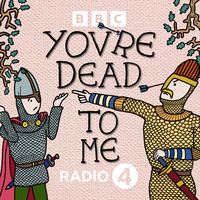The Cold War, Prohibition, the Gold Rush, the Space Race. Every part of your life - the words you speak, the ideas you share - can be traced to our history, but how well do you really know the stories that made America? We'll take you to the events, the times and the people that shaped our nation. And we'll show you how our history affected them, their families and affects you today. Hosted by Lindsay Graham (not the Senator). From Wondery, the network behind American Scandal, Tides of History, American Innovations and more.You can binge new seasons of American History Tellers early and ad-free on Wondery+. Join Wondery+ in the Wondery app or on Apple Podcasts.
https://wondery.com/shows/american-history-tellers/?utm_source=rss
Gesamtlänge aller Episoden: 9 days 10 hours 17 minutes
recommended podcasts
- all
- season 1
- season 2
- season 3
- season 4
- season 5
- season 6
- season 7
- season 8
- season 9
- season 10
- season 11
- season 12
- season 13
- season 14
- season 15
- season 16
- season 17
- season 18
- season 19
- season 20
- season 21
- season 22
- season 23
- season 24
- season 25
- season 26
- season 27
- season 28
- season 29
- season 30
- season 31
- season 32
- season 33
- season 34
- season 35
- season 36
- season 37
- season 38
- season 39
- season 40
- season 41
- season 42
- season 43
- season 44
- season 45
- season 46
- season 48
- season 49
- season 50
- season 51
- season 52
- season 53
- season 54
- season 55
- season 56
- season 57
- season 58
- season 59
- season 60
- season 61
- season 62
- season 63
- season 64
- season 65
- season 66
- season 67
episode 5: Coal Wars | Charles Keeney on Restoring His Great Grandfather’s Legacy
Once the coal miners lost the Battle of Blair Mountain, the story of their uprising was suppressed, and their leader Frank Keeney eventually faded into obscurity—even among members of his own family. But historian Charles Keeney, Frank Keeney’s great grandson, has made it a personal mission to raise public awareness of the mine wars and the pivotal role his ancestor played...
episode 4: Coal Wars | The Battle of Blair Mountain
The Coal Wars reached an explosive climax in August 1921, as thousands of miners furious over the death of their hero Sid Hatfield shouldered their weapons and marched south. Their destination was Mingo County, where they hoped to free their fellow miners jailed under martial law. But first, they would have to cross Blair Mountain and armed men led by Logan County’s ruthless anti-union Sheriff Don Chafin...
episode 3: Coal Wars | Bloody Mingo
In May 1920, Sheriff Sid Hatfield won the loyalty of Mingo County’s miners after a deadly gun battle that left seven Baldwin-Felts agents dead on the streets of Matewan, West Virginia. That summer, the coal companies brought in trainloads of strikebreakers to get the mines running again. But local miners were electrified by the Matewan Massacre and they waged an all-out guerilla war as Hatfield awaited trial for murder...
episode 2: Coal Wars | The Matewan Massacre
In March 1913, famed labor activist Mother Jones was locked up in a shack in Pratt, West Virginia, suffering from pneumonia and a high fever as she awaited court martial. For a year, the striking miners she led endured hunger and violence as they waged their desperate battle for the right to organize. Now, their struggle hung in the balance. West Virginia was under martial law, and hope for victory over the powerful coal companies seemed dimmer than ever...
episode 1: Coal Wars | The Most Dangerous Woman in America
In the early 20th century, coal was the fuel that powered the nation. But the men who mined it in the rugged and remote hills of West Virginia endured harsh exploitation by the coal companies that controlled their lives. In the spring of 1912, miners in West Virginia’s Kanawha Valley rose up against the companies and their powerful allies in law enforcement with a strike for their right to join a union. But the mine operators responded with force...
episode 8: Supreme Court Landmarks | The Outsize Power of the Supreme Court Today
Throughout our series, we've seen how social movements and partisan politics helped influence the decisions of landmark U.S. Supreme Court cases, and thus shape America itself. But how did the Supreme Court get so powerful when America's founders imagined a more limited role? Today, the idea of court-packing, first proposed by Roosevelt to push through his New Deal agenda, is back as a way to rein in the power of the Court...
episode 7: Supreme Court Landmarks | Jane Roe
In 1970, a 22-year-old woman in Texas named Norma McCorvey tried and failed to get an abortion from her doctor. Abortion was illegal in Texas, just as it was in most states. Women hoping to terminate their pregnancies had few options, and many resorted to risky back-alley procedures. McCorvey was soon introduced to a pair of young lawyers who hoped to go to court to challenge the Texas law banning abortion. Before long, McCorvey became the plaintiff known only as “Jane Roe...
episode 6: Supreme Court Landmarks | A Recount in Florida
The morning of Nov. 8, 2000, Americans woke up to an undecided election. Pollsters had predicted a close race between Vice President Al Gore and Texas Governor George W. Bush, but no one knew just how narrow the margins would be. It all hinged on Florida, where 25 electoral votes were up for grabs. Over the next 36 days, armies of lawyers waged a bitter fight to determine how to count the votes in Florida. It was a battle that would eventually find its way to the Supreme Court...
episode 5: Supreme Court Landmarks | The Warren Court
Before the 1950s, the Supreme Court was best known as an institution that adhered to the status quo. It often sought to protect the rights of property owners and businessmen, shying away from cases that took direct aim at controversial social or political issues. But when a popular former California governor became Chief Justice in 1953, all that changed...
episode 4: Supreme Court Landmarks | Loaded Weapon
Through most of 1941, as fighting raged across Europe, the United States held back from entering the war. That all changed in December, when Japanese fighter planes bombed Pearl Harbor and the nation found itself mobilizing for World War II. Suddenly, the frenzy to fight enemies abroad turned to suspicion against those at home. President Roosevelt signed Executive Order 9066, giving the military the power to detain and permanently jail over 110,000 Japanese Americans living on the West Coast...








































